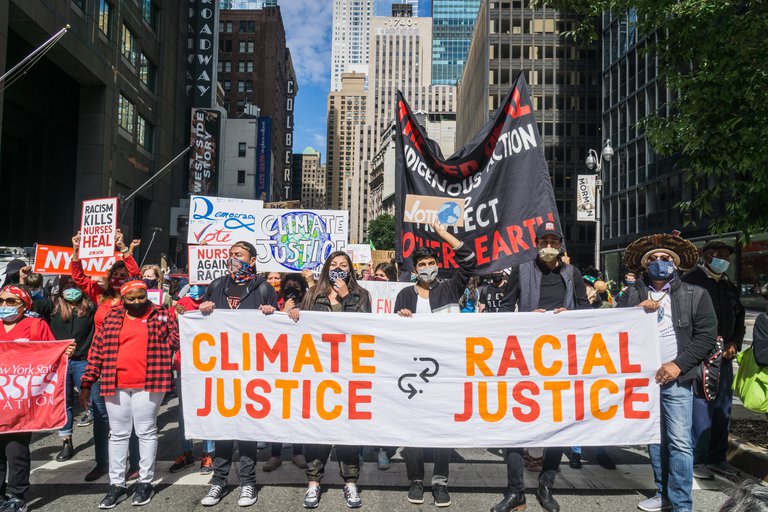


FEATURE ARTICLE
What the Pandemic Taught Us About the "E" in ESG
The past 14 months have exposed various frailties in our society. The COVID-19 pandemic was not a crisis that existed in isolation; its pressure deepened fissures related to the economy, race relations and the ways in which we humans interact with the environment.
For several reasons, the present and future state of the environment moved to the front of our collective minds during the pandemic. As the virus forced people around the world to retreat into their homes, cease travel and consequently reduce emissions of carbon and other pollutants, the natural world began to heal. Humans could clearly see the results of their behavioral changes on the environment.
What’s more, recent increased attention on social inequities has revealed the close link between environmental initiatives and racial justice.
A new presidential administration has deepened its commitment to combating climate change. President Biden’s $2 trillion infrastructure plan revealed an important fact: his administration is betting that investing in sustainable technologies and programs will ultimately pay long-term dividends.
That’s a bet that investors have been willing to make for quite some time.

As we discussed in our last issue, the past few years have seen a steep rise in investments related to matters of environmental and social governance (ESG). In the coming years, as our nation laser-focuses on mitigating the impacts of climate change, we expect those investments to continue — and we believe the “E” in ESG will play a central role in the economy.
Investing with the environment in mind is about so much more than backing “green energy” companies.
Environmental concerns do not exist in a silo; rather, they are inextricably linked to issues of public health, social justice and infrastructure.
The “E” in ESG is complicated, nuanced and enormously positive — for both society and your wallet.
The Pandemic and the Environment
One beacon of light emerged in the dark early months of the pandemic. Amid global stay-at-home orders and reduced travel, the natural world began to thrive. A May 2020 Forbes article noted: “The vibrancy with which the planet has rebounded to the global lockdowns…has revealed how resilient wildlife is, and how quickly nature can recover if given a break.” That rebound included air and water quality improvements and renewed vibrancy of land and aquatic wildlife.
These positive shifts offered cause for hope, but they also underscored the outsized role humans have played in disrupting the environment. Ironically, those disruptions may have contributed to the emergence of the virus that would trigger a global pandemic, and they might make the world more susceptible to future public health crises.
Dr. Aaron Burnstein, Director of the Harvard T.H. Chan School of Public Health’s Center for Climate, Health, and the Global Environment, explained how climate change can create environmental factors that give rise to pandemics. He said, “As the planet heats up, animals big and small, on land and in the sea, are headed to the poles to get out of the heat. That means animals are coming into contact with other animals they normally wouldn’t, and that creates an opportunity for pathogens to get into new hosts. Many of the root causes of climate change also increase the risk of pandemics.”
If the COVID-19 pandemic has proved anything, it’s that we were unprepared to handle its devastation. Part of recovery must be reducing the likelihood of another pandemic — and that will require doing all we can to combat climate change.
“We simply cannot afford to deal with a crisis like this pandemic on top of another climate-related crisis — like a hurricane, tornado, wildfire or heatwave,” said Burnstein.
As we move forward, preventing pandemics and preventing irrevocable climate change will go hand-in-hand. One can’t be done without the other. That means investors interested in precluding another year like this one may be keen to examine their options in ESG investing.

Investing in Environmental Justice
Like issues of public health, issues of racial justice and equity are closely tied to environmental problems and initiatives. Environmental issues do not affect all populations equally. According to the NAACP, “race — even more than class — is the number one indicator for the placement of toxic facilities in this country. And communities of color and low-income communities are often the hardest hit by climate change.” These groups suffer doubly: their proximity to toxic facilities, which contribute climate-changing levels of carbon and methane into the air, can also cause acute and long-term illnesses. They also suffer in greater numbers from property and land loss when climate disasters occur.
The reasons for this race-based disparity are complicated, systemic, and not just related to income. In an August 2020 panel published on Berkeley News, University of California, Berkeley Law Professor John A. Powell spoke about the prevalence of toxic dumps in minority communities. “It’s not explained by socioeconomic reasons,” he said. “A Black person making over $60,000 a year is more likely to live next to a toxic dumpsite than a white person making less than $10,000 a year.”
For these reasons, investing in the environment is closely tied with investing in environmental justice. In a June 2020 interview with Yale Environment 360, environmental justice activist Elizabeth Yeampierre explained the complicated relationship among various crises — public health, environmental and otherwise — in the United States.
“The communities that are most impacted by Covid, or by pollution, it’s not surprising that they’re going to be most impacted by extreme weather events. And it’s not surprising that they’re the ones that are targeted for racial violence. It’s all the same communities, all over the United States. And you can’t treat one part of the problem without the other, because it’s so systemic.”
Investing in sustainable energies and technologies is an important step in reaching a more equitable society. It’s important, however, to ensure that progress happens across all communities, and not just in those populated predominantly by affluent white people.
“A just transition [to a low-carbon future]…looks at not just the outcomes, which is something that the environmentalists look at, but it looks at the process,” said Yeampierre. That process includes “workers’ rights, land use, how people are treated, whether the process of creating materials that take us to a carbon-neutral environment is toxic and whether it affects the host community where it’s being built.”
To maximize impact, it’s important for investors to understand the various ramifications of their investments — even when those investments seem perfectly “green.”
Investing in sustainable energies and technologies is an important step in reaching a more equitable society.

Investing in Infrastructure
Immediately upon assuming office, President Biden demonstrated his commitment to addressing the climate crisis. He appointed two new climate-focused administrative positions (Special Presidential Envoy for Climate and a National Climate Advisor), issued an Executive Order on tackling the climate crisis, and released a $2 trillion infrastructure plan replete with investments in sustainable initiatives, technologies and programs.
Through this bill, the Biden administration is signaling its belief that sustainable investing will reap benefits that transcend protecting the environment. Significant government investment — the bill proposes $174 billion — in electric vehicles and charging stations could lead to a surge in jobs as well as a reduced dependence on foreign oil.
Sustainable infrastructure is closely connected to improving socioeconomic equity by creating good-paying jobs. As CNBC noted, “In an effort to help fossil fuel workers transition to new jobs, the plan also includes $16 billion to employ those workers to cap oil and gas wells and reclaim old coal mines to curb methane leaks. Another $10 billion would establish a ‘Civilian Climate Corps’ to employ people to restore land.”
If the bill passes, the result will not just be environment- or job-related. It will also yield a new pipeline of opportunities for interested investors.
The Economic Benefits of Investing in the Environment
Good news abounds for the growing number of investors interested in supporting environmentally-focused companies. As the head of BlackRock’s iShares Americas recently told CNBC, “ESG investments could become a $1 trillion category by 2030.” The demand is large and growing. According to Kiplinger,
“Sustainable investing accounts for about $1 of every $3 under professional management in the U.S.”
What’s more, seizing those investment opportunities could reap positive rewards — for society, for the environment, and for individual investors. In 2019, the Morgan Stanley Institute for Sustainable Investing found not only that the returns on sustainable funds were comparable to traditional funds, but that investing in sustainable funds was actually less risky.
“Our conclusion is that sustainable funds consistently show a significantly lower downside risk than their traditional counterparts, regardless of the asset class held. This supports…the hypothesis that sustainable funds may potentially offer downside risk protection to their investors.”
The graph below shows just this. The returns between the two types of funds are very similar, however, sustainable funds show a tighter dispersion.
Environmentally-conscious investors can make investments that both align with their values and help secure their futures. As the popularity of ESG investments continue to rise and climate change-related issues become more urgent, investors will have multiple opportunities to support companies that tackle climate change — and, in the process, help create a healthier, more equitable and more economically robust society.
Source
A Sustainable Future
The pandemic has revealed that multiple issues and crises are deeply embedded and interconnected within the fabric of our culture. Decisions that impact the environment have wide-ranging ramifications across society. Issues of public health, racial justice and job security are all intertwined with the policy and economics of the environment.
The pandemic has prompted deeper reflection on how our society functions and how we can create a better future for everyone. By taking a holistic view of the “E” in ESG investing, you can use your hard-earned resources to make a real, long-lasting difference.
If you want to help build a sustainable future, you can. All it takes is a conversation with your financial advisor to begin investing in the areas that matter most to you.





